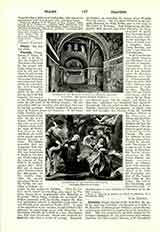

Placidia, GALLA, Queen of Rome, b. in 393; d. November 27, 450; the daughter of Theodosius the Great by his second wife Galla, whom he married in 388 and for whom he afterwards took the field against the usurper Maximus and conquered Italy, which he restored to his wife’s brother Valentinian. The death of the latter put an end to the last imperial dynasty of the Western Roman Empire and Theodosius became the sole ruler of the Roman Empire. He was succeeded (395) by Arcadius and Honorius, two sons by his first marriage. Stilicho conducted the government in Western Rome for Honorius. In his house Galla Placidia grew up to maturity at the side of his wife Serena. When, after the execution of Stilicho, Alaric, with his army of Goths, bore down on Italy and Rome, the wrath of the people against Serena became intense. The opinion prevailed that her vengeance had bid-den this invasion. She was condemned to death by the Senate, which compelled the consent of Placidia to its sentence against her. With this act of desperation, Placidia makes her appearance on the world’s stage. After the second storming of Rome by the Goths, she was taken a hostage by Alaric on his return to Calabria. After the Tatter’s death Ataulf became king, and, urged by Placidia, began peace negotiations with Honorius at Ravenna. These being fruitless, he traversed the Italian peninsula with his Goths, crossed the Alps and established himself in Southern Gaul where he and Placidia were married at Narbo (417). In spite of the opposition of her enemies, Ataulf yielded to her influence in negotiating peace with Honorius. In Barcelona, Placidia gave birth to a son, Theodosius, who died soon afterwards. Death also overtook her husband, who died a victim of revenge. Singerich, his brother, on ascending the throne, drove Placidia from the palace. She was again delivered to the Emperor Honorius by King Waller, and in 416 went to the Court of Ravenna. Next Constantius, the Emperor’s chief general and later Patricius of Gaul, desired to marry her. Necessity forced her consent (417) to the marriage, the fruits of which were a daughter, Justa Grata Honoria, and later a son, Placidus Valentinianus.
In 421 Constantius was made emperor and Placidia received the title of Augusta. Constantius died this same year. Fearful of new disturbances in Ravenna, Honorius sent her to Constantinople. When the latter died (423), Johannes took possession of Italy by force. Placidia, with her son Valentinianus, and escorted by an Eastern Roman army, left for Aquila, and thence to Ravenna. Johannes was conquered and captured. Valentinian III was called to the throne in Rome. Placidia conducted the government as regent with skill and foresight, her advisers being the faithful Boniface, Prefect of the Province of Africa, and the Patricius Aetius. In her children she had little pleasure. Placidia deserves great praise for her services to the Church. She used her influence to further the plans of Leo I when he pleaded with Theodosius II to put an end to the heresy of Eutyches. She built many churches in Ravenna, Rimini, and Rome, restored others, or adorned them with mosaics. Among these are the church of St. John the Evangelist and that of Sts. Nazaro and Celso in Ravenna. Her zeal in the building and beautifying of churches gave a new stimulus to Christian art in the fifth century.
KARL HOEBER

